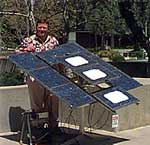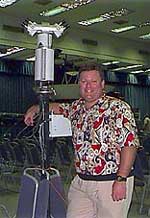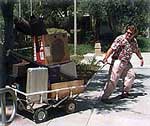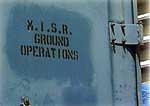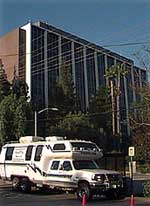 PASADENA,
CALIFORNIA-
PASADENA,
CALIFORNIA-
A lot of people in Pasadena get fairly blase about having the California Institute of Technology, the Planetary Society and the Jet Propulsion Laboratory all inside their city limits, but I just can't. Albert Einstein himself used to roam Caltech's campus, and JPL is where the Mars Rover was born. That would be enough for most places to claim they're the scientific center of the universe, but Pasadena remains remarkably modest, preferring instead to boast about the Rose Parade. Go figure.
|
JPL's
main site can be found at http://www.jpl.nasa.gov |
Anyway, when we received an invitation to visit the hallowed halls of JPL as the guests of one of its brains, we jumped at the chance. Physicist Mark Helmlinger asked us if we'd like to learn more about PARABOLA, the project he's been working on for the last six years. "If you come next Monday, you can help me with a presentation I'm making," he added. "We'll be there," we said. "Put us to work."
We arrived at JPL's 177-acre hillside campus above Devil's Gate Dam around 8 a.m. After receiving our visitors' badges at the front desk, we discovered Mark in a courtyard, where he was constructing an impressive framework of solar panels from meticulously numbered pieces of aluminum and a lifetime supply of silver wing nuts. "Hi," he said. "While I finish doing this, why don't you go into the auditorium over there and set up the computer?"
Hey! We were expecting to lift and carry, or maybe hand out pieces of paper, but this was genuine responsibility! We made our way inside the auditorium, and for the next two hours, I figured out how to run animations on a laptop computer and project them onto a movie screen. Mark played with an enormous overhead projector that looked like a cannon. Meanwhile Mark Helmlinger was outside arguing with a fire marshal about whether it was legal for him to run the cord from his solar panels into the auditorium to power PARABOLA.
Then sixty school children arrived to see a movie in the auditorium. I moved the computer off to one side and watched the movie, too. Afterwards, their guide explained how JPL was started by Caltech students on the "Suicide Squad," who liked to conduct loud and dangerous experiments with rockets. Banished from the Caltech campus, but championed by Theodore Von Karman, one of their professors, they found an isolated place in the hills to continue their projects. The isolated place was about 400 feet from where I was sitting in the Von Karman Auditorium.
At last it was time for 'our' presentation. Mark had prevailed in the dispute with the fire marshal, and he'd set up PARABOLA in the back of the auditorium. PARABOLA, which is the brainchild of JPL's Dr. Don Deering and built by Paul Stockton of the Sensit Company, is an instrument used to validate information gathered by a Multi-angle Imaging SpectroRadiometer, or MISR for short. MISR is a satellite instrument designed to measure sunlight reflected by the Earth into space. The measurements contribute to studies of the earth's ecology and climate. MISR is scheduled for launch into polar orbit aboard NASA's first Earth Observing System spacecraft (EOS AM) in late 1998 as part of NASA's Mission to Planet Earth.
What this means is that Mark gets to travel to isolated places in Nevada and North Dakota, where he sets up PARABOLA. PARABOLA gathers data using eight radiometers. They look at all the sky and all the ground and return one number for every 5 degree circle of the sky and ground for each of the 8 channels. This information can show what a patch of ground will look like from space, and Mark had used it to create the animations I was responsible for showing to the audience during his presentation. He assigned colors to the numbers that PARABOLA had generated, creating a PARABOLA-eye-view of the sun moving across the sky.
I'm proud to report that Mark's presentation went off without a hitch, thanks mostly to the fact that he'd written out a blow-by-blow script for his minions to follow. After it was over, he showed us his office, which is a huge blue truck trailer, and took us to a gallery where photographs and artifacts from famous JPL accomplishments are displayed.
We ended up staying all day, and we departed with the realization that we could spend a hundred more such days at JPL and still have the feeling that we'd barely scratched the surface. Fortunately, a big part of JPL's mission is public education, and up-to-the-minute project information, results and images are available online.
Megan
4/98

